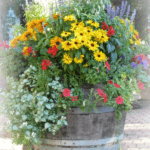Rock and cedar posts are versatile elements that can enhance the aesthetic appeal of any garden. Combining these natural materials can create a stunning and unique look for your outdoor space.
In this article, we will delve into the beauty of using rocks and cedar posts in garden landscaping, exploring the various benefits, types of rocks suitable for decor, how to choose the right cedar posts, creative ways to incorporate them in pathways, garden borders, edging ideas, DIY projects, and maintenance tips.
The timeless beauty of rocks adds a natural and rustic charm to gardens, while cedar posts bring warmth and durability to the landscape design. By marrying these two elements together, you can achieve a harmonious blend of textures and colors that will elevate the overall look of your garden. Whether you prefer a more organic or structured design, rocks and cedar posts offer endless possibilities for creating a personalized outdoor oasis.
As we embark on this journey to discover the potential of rock and cedar post combinations in garden landscaping, it is essential to understand the benefits they bring. Not only do they add visual interest and texture to the space, but they also require minimal maintenance and have long-lasting durability. With proper planning and creativity, you can transform your garden into a serene sanctuary that reflects your unique style and personality.
Benefits of Using Rocks and Cedar Posts in Garden Design
Using rocks and cedar posts in garden design offers numerous benefits beyond just aesthetic appeal. These natural elements can enhance the overall look of your outdoor space while also providing practical advantages. Here are some key benefits of incorporating rocks and cedar posts into your garden landscaping:
1. Durability: Both rocks and cedar posts are known for their long-lasting qualities, making them ideal choices for outdoor environments. Rocks can withstand various weather conditions, while cedar posts are naturally resistant to rot and decay, ensuring that your garden features will stand the test of time.
2. Low maintenance: One of the biggest perks of using rocks and cedar posts in garden design is that they require minimal upkeep. Unlike other materials that may need regular care or replacement, rocks and cedar posts are relatively low maintenance, allowing you to enjoy your garden without constant attention.
3. Versatility: Rocks come in a wide range of shapes, sizes, and colors, offering endless possibilities for creative expression in your garden. Similarly, cedar posts can be used in various ways – as borders, trellises, or decorative elements – adding versatility to your landscaping projects.
By taking advantage of these benefits, you can create a beautiful and functional garden space that will be enjoyed for years to come. Whether you’re looking to enhance pathways, create borders and edging, or add unique decorations to your outdoor oasis, rocks and cedar posts offer a timeless charm that can transform any garden into a sanctuary of natural beauty.
Types of Rocks Suitable for Garden Decor
Rocks are a fantastic addition to any garden, adding natural beauty and texture to the landscape. When combined with cedar posts, the contrast between the rugged rocks and the smooth wood creates a visually stunning effect. There are various types of rocks that are suitable for garden decor, each offering unique characteristics that can enhance the overall look of your outdoor space.
One popular choice for garden decor is river rocks. These smooth stones come in various sizes and colors, making them versatile for different landscaping projects. River rocks are often used in pathways, around plants, or even in water features to add a touch of natural elegance to the garden. Another option is lava rock, which has a rough texture and unique porous surface that can create a striking focal point in your garden.
For those looking for a more organic feel, consider using fieldstones or flagstones in your garden design. These flat rocks can be arranged to create stepping stones, retaining walls, or even stacked as decorative features. Fieldstones offer a rustic charm while flagstones provide a more polished look, giving you flexibility in achieving the style you desire for your outdoor space.
| Types of Rocks | Description |
|---|---|
| River Rocks | Smooth stones available in various sizes and colors; versatile for different landscaping projects. |
| Lava Rock | Rough texture and porous surface; creates striking focal points in gardens. |
| Fieldstones/Flagstones | Flat rocks that can be arranged as stepping stones, retaining walls, or decorative features; offer rustic or polished look. |
Incorporating these types of rocks into your garden design along with cedar posts can elevate the overall aesthetic appeal of your outdoor space. The combination of natural elements like stones and wood adds depth and character to the landscape while providing long-term durability. Whether you choose river rocks for a serene setting or lava rocks for a touch of drama, experimenting with different rock varieties allows you to express your personal style within your garden.
Moreover, when selecting rocks for garden decor, consider factors such as color scheme, size requirements, and maintenance needs to ensure they complement the existing elements in your landscape design. By carefully choosing the right type of rock and combining them with cedar posts strategically placed throughout your garden, you can create an inviting environment that seamlessly blends nature’s beauty with architectural elements for an enchanting outdoor sanctuary.
How to Choose the Right Cedar Posts for Your Garden Project
Cedar posts can add a touch of rustic charm and natural elegance to any garden project. When it comes to choosing the right cedar posts for your garden, there are a few key factors to consider. First and foremost, you’ll want to think about the size and height of the cedar posts.
Depending on the scale of your project, you may need taller or shorter posts to create the desired effect. Additionally, consider the overall aesthetic you’re going for – whether it’s a more traditional look or a modern twist on classic garden design.
Another important consideration when selecting cedar posts for your garden is the quality of the wood itself. Cedar is known for its durability and resistance to rot, making it an ideal choice for outdoor projects that will be exposed to the elements.
Look for cedar posts that are free from knots and other imperfections, as these can weaken the structure over time. It’s also a good idea to choose cedar posts that have been treated with a protective sealant to prolong their lifespan and maintain their natural beauty.
When it comes to purchasing cedar posts for your garden project, you have several options available. You can buy pre-made cedar post kits from home improvement stores or online retailers, which come in various sizes and styles.
Alternatively, if you’re feeling adventurous and want a more personalized touch, you can source raw cedar lumber from a local sawmill or lumber yard and cut and shape the posts yourself. Whichever route you choose, be sure to measure carefully and plan out how many cedar posts you’ll need to complete your garden project successfully.
| Factors | Considerations |
|---|---|
| Size and Height | Determine based on project scale |
| Quality of Wood | Look for durability and resistance to rot |
| Purchasing Options | Pre-made kits or raw lumber based on personal preference |
Creative Ways to Incorporate Rocks and Cedar Posts in Garden Pathways
One of the most charming elements in garden landscaping is the use of rocks and cedar posts to create pathways that not only guide visitors through the garden but also add a touch of natural beauty. Whether you’re looking to enhance a serene meditation garden or create a whimsical fairy tale pathway, rocks and cedar posts offer endless possibilities for creative design.
Here are some ideas to inspire you on how to incorporate these elements into your garden pathways:
- Create a rustic appeal by lining your garden pathway with natural river stones and weathered cedar posts. This combination adds texture and visual interest while blending seamlessly with the surrounding greenery.
- For a more modern look, consider using smooth polished stones set alongside sleek cedar posts. This sleek design can create a contemporary feel in your garden while still maintaining the natural charm of the materials.
- Add depth and dimension to your garden pathway by incorporating varying sizes of rocks with different shades and textures. Mix in rugged cedar posts at intervals to break up the monotony and create visual interest along the path.
Incorporating rocks and cedar posts in your garden pathways not only enhances the overall aesthetic appeal but also provides practical benefits such as durability and low maintenance. These natural materials have timeless beauty that can withstand the elements, making them ideal choices for creating lasting features in your outdoor space.
Whether you prefer a tranquil Zen-inspired walkway or a whimsical stepping stone path, rocks and cedar posts offer versatility and creativity for designing unique garden pathways to suit your style.
Rock and Cedar Post Garden Borders and Edging Ideas
Defined Borders With Cedar Posts
One creative way to utilize cedar posts in garden borders and edging is by creating defined boundaries within your garden space. By strategically placing cedar posts along the edges of flower beds or walkways, you can create a structured and organized appearance. These cedar posts can be left natural or stained to complement the overall aesthetic of your garden.
Natural Rock Edging
Pairing natural rocks with cedar posts for garden borders and edging can add a rustic and charming touch to your outdoor space. Use flat rocks of various sizes to line the edges of your garden beds, pathways, or around trees. The combination of rocks and cedar posts not only adds visual interest but also helps define different areas within your garden while providing a durable border that withstands the elements.
Contrasting Colors and Textures
Another idea for incorporating rocks and cedar posts in garden borders is to play with contrasting colors and textures. Select rocks that vary in color and size to create an eye-catching border along with the warmth of cedar posts. The juxtaposition of rough stones against smooth wood can create a visually appealing contrast that enhances the overall look of your garden design.
By exploring these rock and cedar post garden borders and edging ideas, you can transform your outdoor space into a serene oasis that reflects your personal style. Whether you opt for structured lines with cedar posts or natural rock arrangements, combining these elements will elevate the beauty of your garden while providing long-lasting features that require minimal maintenance. Let your creativity flow as you experiment with different combinations to find the perfect balance for your unique garden setting.
DIY Projects Using Rocks and Cedar Posts for Garden Decorations
Using rocks and cedar posts in DIY projects for garden decorations can add a touch of natural beauty and rustic charm to your outdoor space. The combination of these elements can create visually stunning focal points that enhance the overall aesthetic of your garden. Whether you are looking to create a whimsical garden sculpture or a functional bird bath, there are endless possibilities for incorporating rocks and cedar posts into your DIY projects.
One popular idea for using rocks and cedar posts in garden decorations is creating unique planters. By stacking rocks and securing them with cedar posts, you can build custom planters of varying heights and shapes. These planters not only provide a sturdy base for your plants but also add an eye-catching element to your garden design. You can personalize these planters by painting the cedar posts in vibrant colors or choosing rocks with interesting textures.
Another creative DIY project using rocks and cedar posts is building a charming rock pathway in your garden. By arranging flat rocks on the ground and installing cedar posts as edging, you can create a meandering pathway that adds character to your outdoor space.
This pathway not only serves a practical purpose by guiding visitors through your garden but also introduces a whimsical touch that complements the natural surroundings. Consider adding solar-powered lights along the pathway to enhance its beauty during nighttime strolls through the garden.
Incorporating rocks and cedar posts into DIY projects for garden decorations allows you to infuse your personality into your outdoor space while embracing the beauty of nature. Whether you choose to craft unique planters, build a rock pathway, or explore other creative ideas, working with these natural materials can result in stunning additions to your garden landscape. Take inspiration from the timeless appeal of rocks and cedar posts to transform your outdoor oasis into a truly enchanting retreat.
Maintenance Tips for Rock and Cedar Post Garden Features
Maintaining rock and cedar post garden features is essential to ensure the longevity and beauty of your outdoor space. Proper maintenance will not only preserve the aesthetic appeal but also prolong the life of these natural elements in your garden. Here are some tips to keep your rock and cedar post garden features looking their best:
Cleaning and Sealing Cedar Posts
Cedar posts are durable, but they still require regular maintenance to protect them from moisture, rot, and insect damage. To clean cedar posts, simply use a mixture of mild soap and water, scrubbing gently with a brush. Rinse thoroughly with water and allow the posts to dry completely before applying a sealant to protect them from the elements. A clear sealant will help maintain the natural beauty of the wood while providing added protection.
Weed Control in Rock Gardens
One common issue in rock gardens is weed growth between the rocks, which can detract from the overall appearance of the garden. To prevent weeds from taking over, regularly inspect your rock garden for any signs of weed growth and manually remove them by hand or using a weeding tool. You can also apply a layer of landscape fabric underneath the rocks to prevent weed seeds from germinating.
Inspecting for Damage
Regularly inspecting your rock and cedar post garden features for any signs of damage is crucial for maintaining their structural integrity. Check for loose rocks, cracks in cedar posts, or any other issues that may need attention. Addressing these problems early on can prevent further damage and costly repairs down the line.
By following these maintenance tips for rock and cedar post garden features, you can ensure that your outdoor space remains beautiful and inviting for years to come. With proper care and attention, your garden will continue to showcase the timeless beauty of rocks and cedar posts as integral elements of your landscaping design.
Conclusion
In conclusion, the combination of rocks and cedar posts offers a timeless and natural beauty to any garden landscape. By incorporating these elements into your garden design, you can create a unique and visually appealing outdoor space that will stand the test of time. Whether you are looking to enhance your garden pathways, create borders, or add decorative elements, rocks and cedar posts provide endless possibilities for creativity and personalization.
When choosing rocks for your garden decor, consider using a variety of types such as river rocks, pebbles, or boulders to add texture and visual interest. Pairing these rocks with cedar posts not only adds a rustic touch but also brings a sense of durability and longevity to your garden features. The contrast between the natural elements of rock and wood creates a harmonious blend that can elevate the overall aesthetic of your outdoor space.
For those considering DIY projects using rocks and cedar posts for garden decorations, there are numerous ideas to explore from creating rock-filled planters to building raised beds with cedar post corners. With proper maintenance and care, your rock and cedar post garden features can continue to inspire admiration for years to come. So go ahead, unleash your creativity and transform your garden into a tranquil oasis with the enduring charm of rocks and cedar posts.
Frequently Asked Questions
What Can You Do With Cedar Posts?
Cedar posts are versatile and can be used in various ways. They are commonly used for fencing, creating beautiful outdoor structures like pergolas or arbors, as well as for making furniture such as benches or tables. The natural beauty and durability of cedar make it a popular choice for both functional and decorative purposes.
How Do You Make a Rock Garden Look Nice?
Creating a visually appealing rock garden involves careful planning and design. You can achieve a nice look by selecting rocks of different shapes, sizes, and colors to create contrast and interest. Incorporating varying textures of plants like succulents, ornamental grasses, or colorful flowers can soften the harshness of the rocks and add a touch of beauty to the garden.
How Do You Add Height to a Rock Garden?
Adding height to a rock garden can be achieved through strategic placement of taller plants or trees that complement the rocky landscape. Consider incorporating vertical elements such as trellises, tall ornamental grasses, or climbing vines to add dimension and visual interest.
Terracing the garden with rocks or building retaining walls can also help create levels and increase height variation within the space.

Welcome to my gardening blog! I am passionate about plants and enjoy sharing my knowledge and experiences with others. In this blog, I will write about everything related to gardening, from tips on how to get started to updates on my own garden projects.





